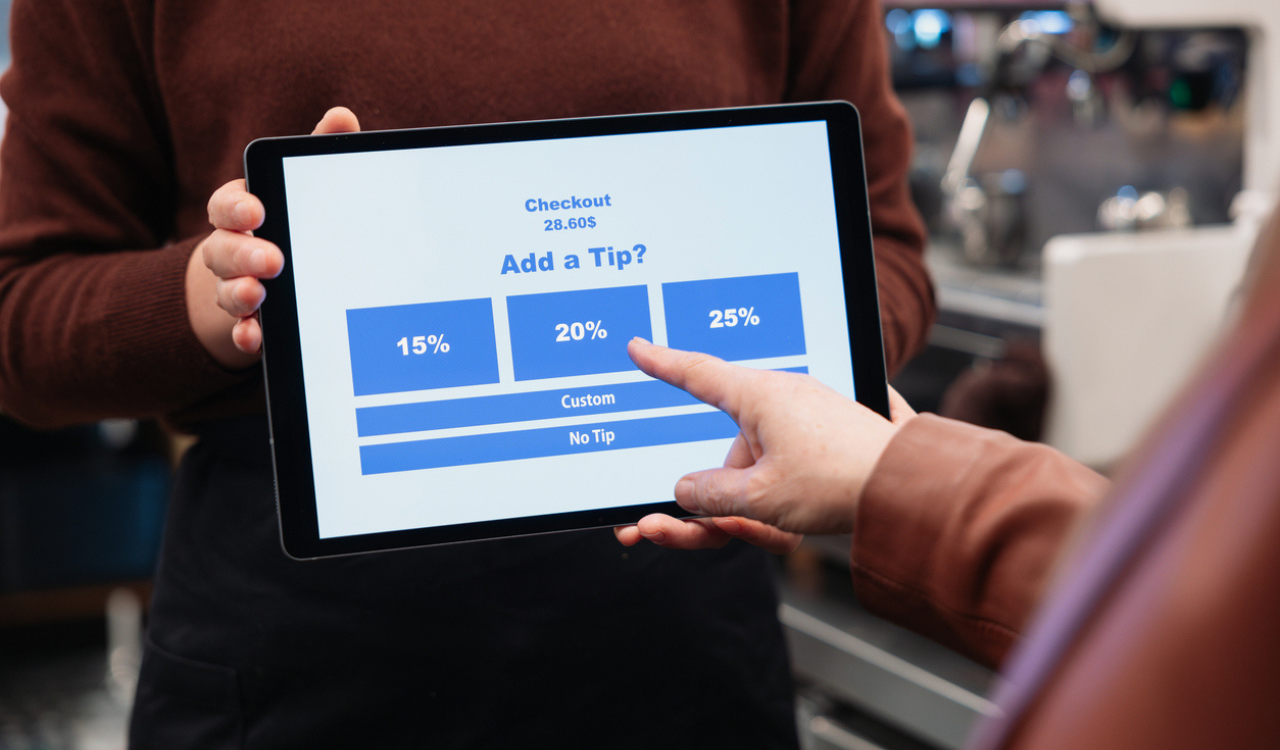Let me be blunt. We’ve reached peak absurdity in American tipping culture, and retailers—particularly in foodservice—need to wake up before they alienate an entire generation of customers. A couple of weeks ago, I spent a few days at the Hilton Garden Inn in Ithaca, New York, and what I saw upset me enough to write this column. On the desk in my room was a placard asking me to tip for housekeeping, something we have all seen in hotels for decades. But this time it was different, it showcased a QR code to make my tipping ‘easier.’ I should add that the desk contained no note paper, pen or other typical amenities we have come to expect.
Research shows that consumers react negatively to service charges added for them, even when those charges would have been voluntary tips. They want to see the breakdown, but they also want to feel in control.
Tipping Burnout
I’ve been tracking consumer behavior for decades, and I can tell you without hesitation that the explosion of tipping prompts at every point of a transaction is not just annoying me and many customers; it’s fundamentally breaking down the trust between retailers and consumers. Nowhere is this more egregious than in quick-service restaurants, where you simply pick up your food and go, and in hotels, where you’re being guilt-tripped into tipping for services that used to be included in your room rate.
Most of Europe figured this out decades ago. They pay service workers a living wage, include service in the price, and treat tips as a genuine bonus for exceptional service—usually just 5-10 percent when it is deserved. But American retailers? We’re doubling down on a broken system and using technology to guilt customers into subsidizing corporate payrolls.
What Europe Got Right (and We Get Wrong)
Before I dive into the current American tipping disaster, let’s talk about how the rest of the world handles this. France legally requires restaurants to include a 15 percent service charge (service compris). In Germany, servers earn between €13-20 per hour before any tips. Sweden and Denmark have such strong labor protections that tipping is often rejected as unnecessary. Italy uses the term la mancia, which means “from the sleeve,” a gift, not an obligation.
What’s fascinating is that in the research in prepping this column I discovered the Journal of Tourism, Culture and Communication, that studied tipping patterns across seven European countries. It found that even though service is included, customers still tip when they receive good service. A 2023 study in the International Journal of Hospitality Management found that income and payment method are the strongest predictors of whether Europeans tip, while bill size determines how much, proving that social norms, not obligation, drive tipping behavior when workers are already paid fairly. The European model works because it’s honest and transparent. Menu prices reflect the true cost of doing business, including fair wages. Customers know what they’ll pay. Workers have income security. Nobody feels ambushed at checkout.
When American restaurants tried to adopt this model, it largely failed. Why? Because we’re the only ones doing it. Danny Meyer’s (the entrepreneur behind Shake Shack, Union Square, Gramercy Tavern and other award-winning restaurants) well-intentioned experiment proved that you can’t revolutionize tipping culture while your competitors across the street still operate on the old model. His innovation was to include service charges in the menu prices. Yet, customers perceived higher menu prices as “expensive” even though they were ultimately paying the same total amount. Meyer’s experiment was brilliant on paper: Raise menu prices, pay staff fairly across the front and back of the house, and eliminate the awkwardness and inequity of tipping. So why did it fail? Customer psychology. That $12 burger became a $14.50 burger. In a real-life example of illogical human behavior, customers wouldn’t pay what they perceived as more expensive, even though they would have willingly paid $12 plus a $2.50 tip.
Joe’s Crab Shack, the first large U.S. chain to implement a no-tip model, abandoned the experiment after just three months. Multiple high-profile restaurants that eliminated tipping eventually brought it back because they were losing front-of-house staff to competitors where they could still make tip money.
The Psychology of Why We Tip (It’s Being Weaponized Against Us)
A recent study published in Management Science by researchers at Tel Aviv University found that tipping is driven by two main forces: genuine gratitude for service and social conformity, that is, the pressure to do what everyone else does. How often have you been in a situation where you split a restaurant bill with another person and then ask, “How much of a tip are you leaving?” Conformity is particularly powerful.
Those digital tip screens are so effective and so manipulative. Research from ScienceDirect published in the Journal of Business Research found that explicit requests to tip actually create “psychological reactance—a threat to customer autonomy.” The study showed that when service providers explicitly ask for tips (especially through digital prompts), it triggers social pressure that hampers one’s perceived control. Customers feel trapped: say no and you’re a jerk; say yes and you’re now subsidizing a business model you didn’t agree to.
Studies published in the Journal of Applied Social Psychology also reveal that tipping behavior reflects racial and gender biases. Female servers may tolerate inappropriate behavior to avoid losing tips, or more attractive servers of both sexes may receive greater tips. A Cornell University study also found that customers tend to tip servers of their own ethnicity more generously.
The Counter-Service Conundrum
Here’s the reality: Average tips at quick-service restaurants have declined from a pandemic high of 16.5 percent in 2021 to 15.8 percent in Q3 2024. Customers are pushing back. They’re tired of being asked to tip 20, 25, or even 30 percent when they’re standing at a counter, placing their own order, filling their own drinks, and carrying their own food to a table. This resistance is especially dramatic now when consumers feel the pressure as prices continue to rise across all sectors, from food and imported apparel to footwear.
In late October, PopMenu’s research found that a staggering 66 percent of consumers say they “sometimes or always” feel pressured to tip when an iPad or digital interface asks them to, even when it’s just a takeout coffee order. And it’s not a new phenomenon. I vividly remember the first time I bought a suit at the now-defunct (and much missed) Barney’s on Seventh Avenue and 17th Street. My salesman quietly told me to be sure that I tipped the tailor at least $20 to make sure I received the best tailoring. And that was in 1975!
Behind the Curtain
Let’s talk about what’s really happening. For supermarket and restaurant delivery and takeout, 29 percent of diners don’t tip at all; only 12 percent say they tip 20 percent or more. This massive disparity tells me that consumers fundamentally don’t agree on what deserves a tip anymore for convenience and personal service.
The data is clear: Yelp reviews mentioning “tipflation” increased 399 percent from May 2023 to April 2024. Customers are willing to tip generously for full service and exceptional experiences, but they’re rebelling against tip prompts where minimal service is provided. A Horizon Media survey found that 81 percent of consumers preferred the status quo of voluntary tipping. Why? Back to Danny Meyer, 55 percent worried that building a service charge into menu prices would force them to pay the tip whether the service was good or bad. In fact, 52 percent wanted control over how much they paid rather than having a flat fee imposed.
The Hilton Horror Show
Back in Ithaca, when I checked into the Hilton Garden Inn, I saw tipping culture at its most obnoxious. Hilton is not the only one; major hotel chains are also placing these QR codes on signs in hotel rooms, asking guests to tip. Hilton’s CEO acknowledged he doesn’t tip housekeeping himself. Think about that. The CEO of a multibillion-dollar hotel chain doesn’t tip the housekeepers, but he’s asking me to do it! And here’s the kicker, many Hilton properties (including the one in Ithaca) only provide housekeeping every other day, or upon request. So, I’m being asked to tip for a service that’s been reduced or eliminated.
In 2014, Marriott started putting envelopes in hotel rooms to encourage housekeeping tips. But full disclosure, HEI Hotels & resorts CEO Ted Darnall admitted encouraging tipping was a way to avoid raising wages. There it is—the inconvenient truth. These corporations are using guilt-driven technology to outsource their labor costs to customers who are already paying premium prices for rooms. Technology brands are partners in crime. Hotels are now offering digital tipping through Apple Pay, Google Pay, and Venmo, making it easier than ever to guilt guests into tipping. They say this payment option is designed specifically to reduce “friction,” which is corporate-speak for making it harder for you to say no.
What This Means for All Retailers
- Tip fatigue is real and measurable. The average tip on Square’s digital food and beverage transactions fell to 14.9 percent in Q2 2025 from 15.5 percent in 2023. The overall tipping average for restaurants came in at 18.8 percent in Q3 2024, down from 19 percent in Q3 2022. While .2 percentage points may not seem life-changing, in the aggregate, customers are actively tipping less because they’re being asked to tip everywhere at a time when most people are feeling the pinch on higher prices on just about everything.
- Transparency matters more than ever. Research shows that consumers react negatively to service charges added for them, even when those charges would have been voluntary tips. They want to see the breakdown, but they also want to feel in control. This is why automatic service fees, including those listed as health and welfare for the kitchen staff, have sparked backlash.
- Set reasonable expectations. If you must have tip prompts at counter service, list reasonable amounts: 15, 18, 20—not 25 or 30 percent. Better yet, make tipping truly voluntary. Here’s an idea. How about communicating “Tips are appreciated but never expected” at counter-service establishments?
- Pay your people fairly. This is core to the problem. If you can’t afford to pay your workers a living wage without relying on customer tips, your business model is broken. Fix your model, don’t guilt-trip your customers.
The Bottom Line
We’re at an inflection point. The number of people who “always tip” has dropped from 77 percent in 2019 to 65 percent in 2023. This isn’t because customers have become stingy—it’s because they’ve been asked to subsidize corporate profits one QR code at a time.
For retailers, especially in foodservice, the message is clear: Respect your customers’ intelligence and their wallets. If you’re providing minimal service, don’t ask for maximum tips. If you’re a hotel charging $300 a night, pay your housekeepers a decent wage instead of asking guests to scan a QR code to make up the difference.
The companies that figure this out—that understand tipping should be reserved for authentic service, not automated transactions—will win the loyalty war. The ones that keep pushing QR codes and guilt trips will find themselves on the wrong side of a consumer backlash that’s already well underway.
Trust me on this. Your customers are keeping score. And right now, retailers are losing.





